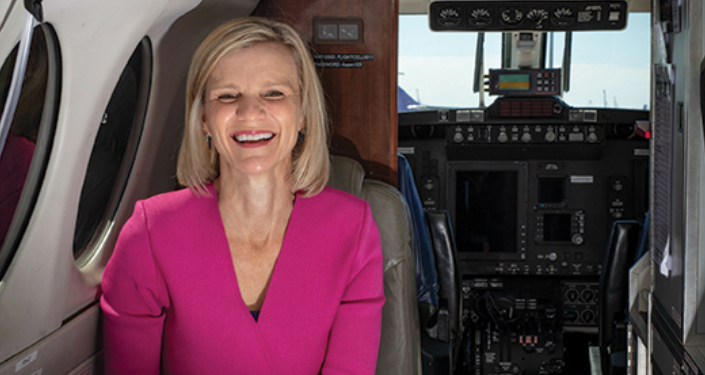When working life gets particularly stressful, many managers and leaders utter the old adage, ‘We’re not saving lives’. And, for most CEOs, that’s absolutely true.
But what if the organisation you lead actually does – literally – save lives? And then, what if your organisation also happens to be one of the most quintessential Australian brands in existence – right up there with Vegemite and the Sydney Opera House?
Oh, and just to keep it interesting: Let’s say that you and many of your staff spend large parts of your working lives flying long distances at breakneck speeds in tiny aircraft.
Now that is pressure on a whole new level.
Meredith Staib MIML agrees that being CEO of the Royal Flying Doctor Service (Queensland) is not a job for the faint-hearted. But she’s loving her role heading up one of the largest and most comprehensive aeromedical organisations in the world.
BUILT FOR THE TASK
Before joining RFDS, Staib was already one of Australia’s leading emergency assistance executives. She had provided leadership to global organisations such as the Cover-More Group (part of Zurich) and Allianz Global Assistance. Her experience also spanned clinical and corporate management roles in the health, medical assistance and travel insurance sectors.
As if all that weren’t enough, Staib has also held international board positions including being an executive committee member of the International Assistance Group (IAG) in Paris, France. In that role she shared global accountability for the IAG’s continued success and led the board in developing and defining IAG’s strategy.
That career trajectory suggests that Staib must be a strong and implacable leader. But is there anything that does scare her? And how does she manage a remote workforce scattered across more than one million square kilometres of land? IML ANZ chief executive David Pich CMgr FIML caught up with Staib to find out.
DAVID PICH: When someone thinks of the RFDS, it’s obviously the planes that spring to mind. But there’s a lot more to it than that isn’t there?
MEREDITH STAIB: That’s right. It’s not solely an aeromedical organisation. It does so much more. We provide free dental care. We’ve got a big mental health program. In fact, that’s probably one of our most rapidly growing programs. We do about 25,000 primary health consultations annually. We employ about 380 people including pilots, nurses, doctors, allied health professionals, mental health clinicians, dentists etc. We’ve got nine bases across Queensland, with 19 aircraft. In fact, if you combine all the aircraft across all the RFDS sections, we’re Australia’s third-largest airline after Qantas and Virgin.
MASTERING COMMUNICATION
DP: As a leader, how do you manage staff when they’re spread across a vast State like Queensland?
MS: Obviously, our people in Brisbane get to see the senior leadership team a lot of the time in the corporate office. But the experience is different for those based remotely. As a leader, the key to that is communication and making yourself available. You have to be clear on your strategy and make sure everyone knows the vision and mission of the organisation, and where we’re going. It’s important that the senior leaders in the business share that.
DP: What about face-to-face communication?
MS: Technology has made communication a lot easier, of course, with video conferencing, Skype, social media and so on. But as a leader, you really need to walk the floor. I’m a big advocate of that because you can’t sit in an office and expect all the information to come to you. So you need to be out among the people. Within 90 days of starting at RFDS, I made it a priority to get out and around to our bases. I’ve lived in Queensland for a long time but, when I made those trips, it really brought home to me what a vast state this is.
SOLIDIFYING STRATEGY
DP: The RFDS has existed for 90 years and some people might think, ‘Well, the CEO just has to keep the organisation strategy on the same track as before’. Is that the case?
MS: When I joined, the organisation had just formalised a five-year strategy and we’ve just started on that journey. But my experience of strategy is that you can’t ‘set and forget’. You should be reviewing your strategy every six months because things change. It could be technology, it could be people, it could be regulations. You need to be ahead of the game strategically. I think it’s also important to check in with people regularly, to align their work to the wider strategy. Then every year, our board has an offsite strategic board meeting in one of our bases to review the strategy. Are we still on track? Is it still right for the business? After my first 90 days in the role, I had the opportunity to present to the board. I validated that we have the right strategy and, as CEO, I was turning my mind to execution.
DP: And as a leader, a big part of strategy execution comes down to people, right?
MS: Yes, absolutely. People are one of the main pillars of our strategic delivery. I think they are the RFDS brand – that’s how important they are. I’ve been really struck how people are willing to represent the brand, and go the extra mile to make a difference.
People are also central to my thinking when I focus on future-proofing the organisation. We rely upon four skillsets that are in very short supply in Australia and overseas: pilots, nurses, mental health clinicians and doctors. So we can’t rest on our laurels there. We need to make sure we’re an employer of choice and we attract and retain talent. We need to support colleagues if they need to go and live somewhere remote, away from their family. Or if they need to work shifts, because we operate 24/7. Or if they need to work out of hours to support fundraising and community events.
DEVELOPING LEADERSHIP SKILLS
DP: Your workforce is clearly very passionate about what they do. They literally change the course of people’s lives for the better. However, that can sometimes come with a flipside can’t it? Passionate people can be amazing with their technical specialism, but not always strong at managing and leading those around them.
MS: I started out as a nurse myself and have worked with clinical professionals for most of my career. You shouldn’t assume that because someone is technically a great clinician, they’ll naturally be a great manager. Leading others is a skill people have to learn. I’ve been fortunate to develop the skills to manage people and drive organisations forward – but that has required training, qualifications, and experience. I think it’s our responsibility as leaders to provide those kinds of development opportunities for technical specialists who want to grow. We need to help them build upon the technical foundation they already have.
DP: Does mentoring have a role here too, do you think?
MS: Yes, I’m a big supporter of mentoring. It’s invaluable if you can have a person outside your organisation offering advice and guidance. That external perspective is so useful. I’ve been both a mentee and a mentor during my career and all those experiences have helped me professionally. When I look back over my own career, I’ve sought to learn something from all the leaders who I have worked with. I think that’s how you develop your own leadership style.
MANAGING RISK AND STRESS
DP: Flying planes in the air and dealing with medical emergencies, your organisation is exposed to a fair amount of risk. As a leader, how do you manage that?
MS: It’s when leaders underestimate risk that you run into challenges. So I take a rigorous approach to managing it. From my previous career experience, I understand health risk. And RFDS has got really strong clinical governance.
I’ve now learned a lot in a short space of time about the aviation side of the organisation too. As part of my leadership role, I hold the Air Operator’s Certificate from Australia’s Civil Aviation Safety Authority. So ultimately, should something go wrong, then that will rest with me as the manager holding the licence. That’s a lot of responsibility but I’m comfortable with it as I have an expert team in the aviation space.
So, I know I’ve got the right people in the right place. We have defined structures around reporting. These people have direct access to me, and I meet with them regularly. I think the main thing I need to do as the responsible manager is make sure they feel that we have an open and collaborative relationship. If they need me to raise any risk issues with the board, then that’s what I’m here for.
DP: Collectively, your organisation deals with life or death situations all the time. On a personal level, how do you manage stress?
MS: Like many people in the health sector, I’m passionate about what I do and consequently it can be challenging managing work-life balance. But my home life is a welcome distraction from work. I like to run and do gardening. I have two great kids and they help me switch off from work. The normal things like, ‘Mum, where’s my school hat?’ and ‘I need help with my homework’. That all helps.
But I don’t think anyone takes a senior leadership role and expects it to be a nine-to-five job. And modern technology means that everyone in today’s workforce is virtually connected 24/7. You can either see that as a challenge or an opportunity. I think it’s quite liberating to be able to work from anywhere in the world.
The full version of this article originally appeared in the September 2019 print edition of Leadership Matters, IML ANZ’s quarterly magazine. For editorial suggestions and enquiries, please contact karyl.estrella@managersandleaders.com.au.
 Jillian Cable CMgr FIML
Jillian Cable CMgr FIML Carol Sutton CMgr FIML
Carol Sutton CMgr FIML Michael Coe CMgr FIML
Michael Coe CMgr FIML












